Joint effects 2011 - An update of the involvement - 18 Weeks
Joint effects 2011 - An update of the involvement - 18 Weeks
Joint effects 2011 - An update of the involvement - 18 Weeks
Create successful ePaper yourself
Turn your PDF publications into a flip-book with our unique Google optimized e-Paper software.
<strong>Joint</strong> <strong>effects</strong> <strong>2011</strong><br />
There is much greater standardisation <strong>of</strong> assessment and referral forms across<br />
many health boards and more patient information provided although <strong>the</strong> extent and<br />
content varies.<br />
There has been a lot <strong>of</strong> pathway and redesign development, which continues as<br />
part <strong>of</strong> <strong>the</strong> current National MSK Redesign Programme.<br />
The regular use <strong>of</strong> systems and technology to support patient care still remains<br />
highly variable. Some services have, and make good use <strong>of</strong>, legacy systems. O<strong>the</strong>rs<br />
have built <strong>the</strong>ir own databases to support quality improvements but <strong>the</strong>re are still<br />
many services that are dependent on paper for <strong>the</strong> retrieval <strong>of</strong> patient outcomes.<br />
Many but not all have access to e-GP referrals and some specialised services are using<br />
e-vetting very successfully.<br />
The lack <strong>of</strong> systems and diary management can only hamper flexible and adaptable<br />
service development, however some services have effectively used <strong>of</strong>f-<strong>the</strong>-shelf<br />
products as an interim measure.<br />
Advanced AHP practice in partnership with o<strong>the</strong>r clinicians forms <strong>the</strong> basis for many<br />
services. Most services are delivered within community settings, health centres and<br />
community hospitals. Ensuring advanced practice is integrated into normal services<br />
and not seen a ‘stand-alone’ is clearly a current development in some boards. The<br />
use <strong>of</strong> injection <strong>the</strong>rapy is now widespread throughout physio<strong>the</strong>rapy and podiatry in<br />
Scotland and in some places available within every service.<br />
Increasing links to exercise and better integration <strong>of</strong> work, health and leisure are<br />
evident; some boards lead <strong>the</strong> way in this. Staff skill mix has been adjusted to include<br />
exercise and fitness pr<strong>of</strong>essionals within <strong>the</strong> traditional healthcare team. There are also<br />
examples <strong>of</strong> exercise classes being targeted at particular populations and links with<br />
<strong>the</strong> voluntary sector to deliver patient-led group activity.<br />
In <strong>the</strong> hospital sector <strong>the</strong> use <strong>of</strong> education classes in preparation for planned joint<br />
replacement surgery is becoming widespread.<br />
Conclusion<br />
Scotland has led <strong>the</strong> world in permitting and promoting self referral to AHP services,<br />
this approach now underpins Scottish Government Policy, but many AHP services are<br />
still quite difficult to find on <strong>the</strong> internet. How patients and <strong>the</strong> public learn about self<br />
referral is also difficult to judge. The NHS 24 pilot may assist with this.<br />
AHPs are in a unique position to support and promote Scottish policies on working<br />
health, and assist as many people to stay at work, or return to work as soon as<br />
possible. More needs to be done to establish links with leisure services and to be<br />
effective advocates for physical activity and public health.<br />
Services will have to demonstrate <strong>the</strong>y are not only effective and efficient but that<br />
<strong>the</strong>y add value. The national approach to consistent outcome measurement will<br />
support this.<br />
There continues to be variation in <strong>the</strong> delivery and management <strong>of</strong> musculoskeletal<br />
services between and within individual health boards in Scotland. This is also<br />
confirmed by The Arthritis and Musculoskeletal Alliance (ARMA)’s Musculoskeletal<br />
Map <strong>of</strong> Scotland due for publication later this year.<br />
It will be important that <strong>the</strong> good practice identified in this report and <strong>the</strong><br />
opportunities <strong>of</strong>fered by <strong>the</strong> National MSK Redesign Programme are used<br />
to reduce variation and continue to drive improvements in <strong>the</strong> quality <strong>of</strong><br />
musculoskeletal services for <strong>the</strong> people <strong>of</strong> Scotland.<br />
13<br />
mskscoping<strong>2011</strong>-rs.indd 13 03/11/<strong>2011</strong> 11:01


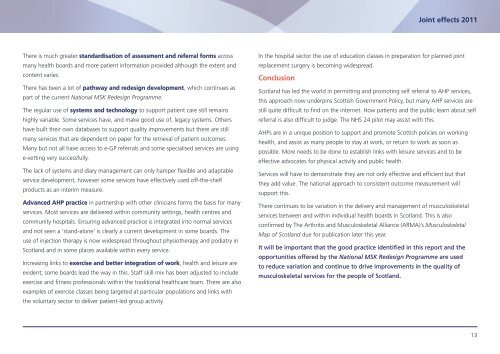
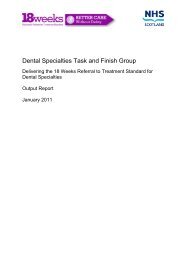
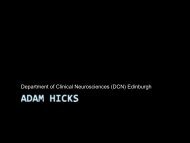
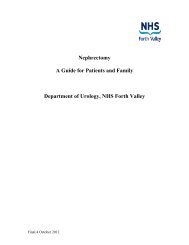
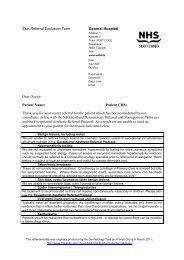
![Dr Matthew Checketts, NHS Tayside [PDF - 6Mb] - 18 Weeks](https://img.yumpu.com/49027155/1/190x143/dr-matthew-checketts-nhs-tayside-pdf-6mb-18-weeks.jpg?quality=85)
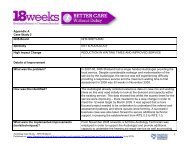
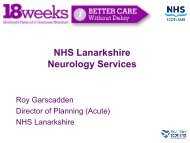
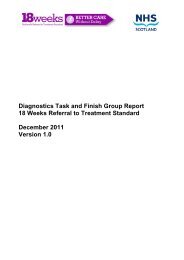

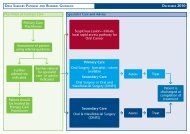

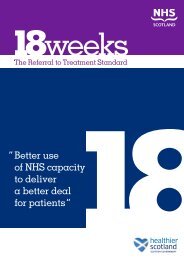
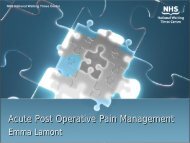
![Mark Sindall, NHS Dumfries and Galloway [PDF - 227Kb] - 18 Weeks](https://img.yumpu.com/30080335/1/190x143/mark-sindall-nhs-dumfries-and-galloway-pdf-227kb-18-weeks.jpg?quality=85)